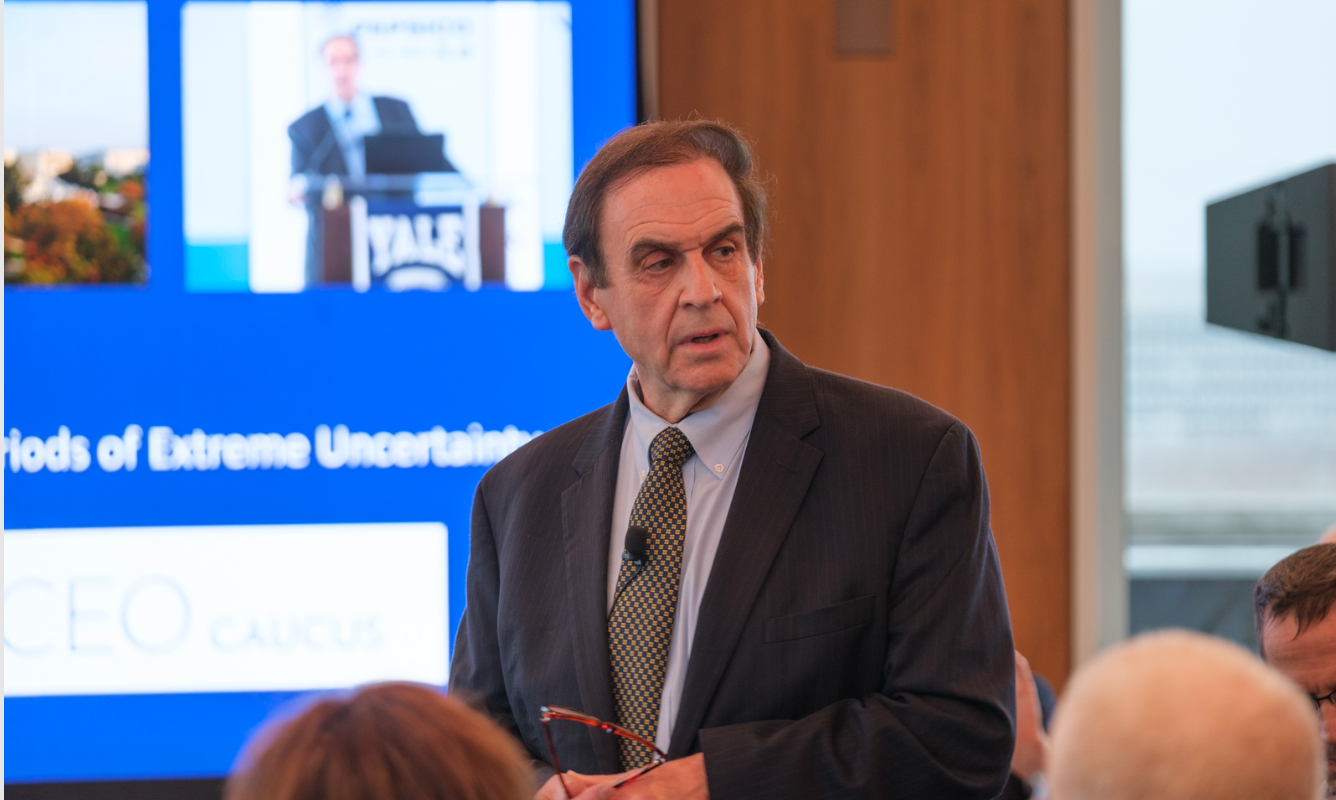Profiles in Disruptive Leadership
“There has been a shift in what’s expected of leaders over the last 30 years. No longer can a leader just keep a steady hand on the rudder of an enterprise. Today, leaders are expected to cut a new path in the marketplace for their organization, to disrupt business as usual. They are expected to have a bold vision of the future and marshal the forces that it will take to get there. No one understands the shift in what it means to be a leader better than those who are actually leading. That’s why we talked to several of today’s top leaders and asked them about the challenges they face, how they overcame them, and the importance of disruption. What we found out was eye opening, and educational. These leaders had several characteristics in common. They are not just visionary, they are at work making sure a particular future is possible. The future they seek is bold, compelling, and captures the very essence of winning. They take time to build trust and bring people along — speaking authentically and operating with consistency and integrity. They encourage inventive and unorthodox action. They build their company’s culture, then they build it some more.” —Shideh Sedgh Bina Most importantly, these people embody disruptive leadership.
DR. DAVID EBSWORTH

CEO, GALENICA LTD. // CEO, VIFOR PHARMA // CHAIRMAN OF THE EXECUTIVE COMMITTEE, GALENICA AG
What are some of the unique challenges that leaders today face, and how should they address them?
Resources are much more limited in my industry today than before. Regulations cover nearly everything and are changing constantly. Currency fluctuations have a massive impact on international businesses. These issues can be addressed by developing and following a long-term vision for the business and building the capability in the organization to understand the strategy, know each unit’s role in delivering this strategy, and setting up processes which enable action, with a clear understanding of each unit’s freedom to act.
What are the three or four factors that are most critical to managing as a disruptive leader? How do you address each one?
Having a clear vision of the future — Requires long term focus on the key factors to deliver. Challenging employees to be better than they think possible — Supporting rebels and people with the commitment to deliver. Forgiving mistakes and learning from them — Requires clear examples to be credible.
In a recent insigniam executive sentiment study, 87% of executives said that innovation was critical to their continued competitive advantage, yet only 15% felt their organizations were well prepared to deliver the requisite innovation. In your opinion, why is there such a disparity?
The speed of business is accelerating. Most organizations thrive on what they have done well in the past. This difference creates the issue. Few organizations support and reward innovation in a clear way.
Can you quickly share some of your leadership challenges and how you addressed them?
When I started in my new job, most people believed our most advanced development project was too late and too expensive to develop. I identified the key success factors with a cross-functional team approach and challenged them to deal with the issues. A year was cut from the time, and cost reduced significantly. As a result, a partnership deal was possible, which delivered significant short-term revenue.
What have you done to create the conditions for sustained innovation in your enterprise?
Not enough! More process is needed and the support of the true innovators should be clearer to the whole team.
TOM SANTORA

CHIEF MARKETING OFFICER, OMNI HOTELS & RESORTS
What are some of the unique challenges that leaders today face, and how should they address them?
Businesses of all sizes and types face a number of challenges today. While some of the issues aren’t new, the combination and complexity of the issues can make them particularly difficult. For example:
→Pace of Change
Market changes occur much more rapidly than in the past. As a result, leaders must be able to effectively manage change and quickly adjust business models to adapt to market dynamics. We have more data than we know what to do with. However, today’s leaders must be able to adapt constantly and be extremely nimble in order to move business forward.
→Globalization
Almost every company must deal with globalization. Even if they choose not to operate globally, they may have global competition or global suppliers — and more than likely, customers and/or employees representing different global regions of the world. It’s imperative to ensure employees throughout the organization are aware of and are sensitive to cultural diversity among colleagues, customers, and suppliers. At Omni Hotels & Resorts, we leverage our affiliation with the Global Hotel Alliance to remain competitive in this space.
→Employee Recruitment & Retention
Today’s workforce has much higher expectations for work/ life balance, workplace flexibility, benefits, workplace culture, and career advancement opportunities. Creating an environment that thrives on dynamic change will address the needs of the company and its employees.
→Social Media
I just read that Google found nearly 60 percent of people talk more online than they do in-person. Crowds are naturally forming online so that today a single unhappy customer can become a weapon of mass persuasion. As a result, a company’s reputation is more difficult to manage than ever. Companies must be flexible in how they communicate with customers, whether it be via phone, email, on Twitter, Facebook, Pinterest, Instagram, YouTube, or using a Vine video. Essentially, we must be prepared to listen and communicate to each audience in the manner they prefer.
What are three qualities that a disruptive leader must have?
To keep up with the rapid pace of change, disruptive leaders must possess three important qualities:
- Intellectual curiosity: Disruptive leaders like to learn. They are intellectually curious and proactively investigate new things, identify and solve never-seen-before problems, and apply new ways of doing business. They are willing to be proactive and responsibly experimental, discovering innovations others may not see.
- Fierce competitive nature: Competition is tough, and conditions can be unpredictable and unforgiving. Disruptive leaders must be fierce, focused, and goal driven. They must ensure their organizations have a deep knowledge of their competition and a thorough understanding of what it will take to take the top position.
- A thick skin: I’ve heard it said that a diamond can’t be polished without friction. That same principle applies in business today. Disruptive leaders can’t maximize their potential without being tested by adversity. Disruptive leaders are unafraid of calculated risks, using obstacles and setbacks as opportunities to polish their strategies and skills. We live by the mantra “when others see obstacles, Omni sees opportunities.”
What is a leadership lesson you had to learn the hard way?
I was assigned my first leadership role at a relatively young age. As a result, I felt a tremendous pressure to prove myself and demonstrate my ability to succeed on my own. I had difficulty asking for help from my peers and coworkers. But I’ve learned I cannot be all things to all people, and I cannot sustain the growth and success of my organization by myself. I’ve developed the ability to find the right people, put them in the right places, and rely on them to help build and sustain the company. You need to surround yourself with people that know more than you!
MURIEL PÉNICAUD
GENERAL MANAGER OF HUMAN RESOURCES, DANONE
Why should leadership disrupt business-as-usual?
For me, being disruptive is precisely the difference between leadership and management. A manager motivates and brings together the teams. A leader embodies a vision and transforms business. Both are important, but if you really want to transform — and it is essential for a company to be able to transform — you need leadership.
What does a disruptive leader look like?
A disruptive leader catalyzes collective energy. He/she knows how to listen and is able to detect, to interpret weak signals. He/she is open minded and curious of everything. But most importantly, a disruptive leader has his/her own style. Being a leader has to do with your personality, not with a defined role. There is no recipe to be a good leader, you have to be yourself. You have to accept who you are and draw from your inner resources to really impact. Being who you are also means you
have to know the difference between being popular and able to draw others with you because you embody a vision. If you want to be a leader, you have to distance yourself from being popular, because when you see and anticipate things, when you move fast, when you face big transformations, you can be quite alone sometimes. But it doesn’t mean you have to stay alone! Someone that stays alone is a pioneer, not a leader.
What are some of the unique challenges that leaders today face, and how should they address them?
The speed at which businesses transform makes information more and more complex, situations more and more interdependent. It makes information all the more difficult to capture and integrate. We can’t think and act anymore as we used to do, using forecasts and perspectives to anticipate the future. In fact, we don’t know what the world will be in 10 years. Therefore, a leader cannot be just a visionary, he has to be the one who makes the future possible. Another challenge is the change in our collective culture and ways of working. In a world where the networks have an increasing role and the new generations at work are constantly interconnected, the traditional “vertical” management style will not work anymore.
What aspect of leadership surprised you? Is there anything that’s harder than you thought it would be? Is anything easier?
One of the things I discovered is that not everyone wants to be a leader. It really has to do with who you want to be. On the other hand, the easy aspect of leadership is that you only have to be yourself. Being a leader has much more to do with who you are than with what you do. I remember a speech I did once, and I had a standing ovation at the end. All I had done was talk about my experience as a woman and a leader! In my generation, women still tried to imitate men’s leadership. I feel that nowadays the context has evolved. It is much more conducive for women to express who they are. By being yourself, you accept who the others are. One of the things I love is discussing with leaders from other cultures, you have a genuine respect on both sides for who the other is, what his or her background is.
What is a leadership lesson you had to learn the hard way?
That nothing can ever be taken for granted. This is something I learned some years ago when I was working in a French minister’s cabinet. I had set up a disruptive program aimed at combating illiteracy. It was innovative, and the results were extremely positive. I thought that this program, being both innovative and successful, would be extended even though the political majority had changed. But the program’s expense caused the new minister to suppress it. What I learned from that is that you always have to keep in mind that things can change, and that no improvement is guaranteed to last forever.
DARREN CHILDS

CEO, UKTV
Can you quickly share some of your leadership challenges and how you addressed them?
I came to lead UKTV because I saw a business with huge potential to grow and be a serious player in the media industry. When I joined, I could see the opportunity ahead and talked excitedly about how we could grow and be more successful and more creative by being more commercially focused. I had a clear ambition to do more of what we did, with incredible content and brands, and I had the excitement and energy to make it happen. I talked about the future with the intention of my vision being contagious… but learned quickly that people valued their creative heritage and were fiercely protective of it. I knew I needed to quickly build the trust of the people — it’s the foundation of any high performing organization. … I care about each individual and spend as much time as I can engaging with people at every level about what’s happening in the business and their wider lives. I took the time to explain that I saw our future as having a balance of creativity and commercial focus — that one could not operate without the other, and I intentionally shared more about how much I valued the creative heritage.
What aspect of leadership surprised you? Is there anything that’s harder than you thought it would be? Is anything easier?
Experience tells me that the most critical role I have as a leader is creating the right culture for people to bring their best each day and thus deliver outstanding work. I’m really proud of our latest accolade at UKTV that we are the only British broadcaster to ever be recognized by Best Companies to Work for, picking up a special award in 2013. ‘Culture eats strategy for breakfast’ has never been a truer saying.
In a recent insigniam executive sentiment study, 87% of executives said that innovation was critical to their continued competitive advantage, yet only 15% felt their organizations were well prepared to deliver the requisite innovation. In your opinion, why is there such a disparity?
Innovation is becoming a buzzword, and, although I’m a great believer that innovation is critical for continued success, the disparity exists because people in organizations don’t see the link between the aspiration to be innovative and what they have the power to do in their everyday work. The risk with innovation is that it feels so big that only a few people can take responsibility to create a bright, new and shiny ‘innovation.’ If we talk about inventiveness and help people to understand what that means, it’s much more tangible. Being inventive is about looking at new or different ways to do what we do today as well as new ideas or products that feels like big leaps for the future. Most major innovations come from connecting a number of smaller ones, and encouraging everybody to think about it just increases your chances of a real breakthrough.
What have you done to create the conditions for sustained innovation in your enterprise?
In UKTV, I’ve created a culture where we give people the space to find new ways of approaching their work, busted silos so that people know what the impact on others will be of a new idea, encourage the idea generator to own it through to delivery, celebrate success, and learn positively from failure. We invest time in mentoring and coaching individuals to help them grow confidence in creating new breakthroughs. Our recruitment, development, and appraisal processes are all designed to support our belief that we’re a challenger brand with big potential. We hire people with the right values fit and develop them so that they can be the best. My mantra is that this is the place people will do the best work of their careers. We don’t leave innovation to chance. One of my first initiatives was to sponsor an ‘innovation fund’ where anybody could easily access funds and mentoring to make great ideas happen without going through the formal business case process. For me, innovation doesn’t need definition or structure — it needs fuel.
GEORGE HONGCHOY

CEO, THE LINK MANAGEMENT LTD.
What does a disruptive leader look like?
The demonstration of disruptive leadership in a company represents a positive force to embrace change. A successful leader should revisit the company’s problems and opportunities from time to time. Instead of looking at them in the same way, leaders should reframe them using multiple perspectives. Disruptive leaders should be open to taking risks since risks amount to more than just possible threats to normal business operations; taking calculated risks can also help a company create new paradigms. Disruptive leaders should not avoid making mistakes, but should view failure as a way to unveil existing weaknesses and achieve better overall performance. As the old saying goes, “Failure is the mother of success.”
How do you gain a competitive edge in a world where leaders and companies have already developed the ability to embrace and integrate ongoing change?
In today’s business world, many leaders and companies have already developed the ability to embrace and integrate ongoing change. In order to further differentiate ourselves, I lead my team by constantly focusing on creating business breakthroughs. Also, people should keep stretching their boundaries beyond their comfort zones so that they can grow and develop.
Can you quickly share some leadership challenges and how you addressed them?
Fresh markets exist in every community in Hong Kong. They provide convenient shopping venues and gathering points for the community, but they have long been perceived as old-fashioned and dirty, especially compared with the antiseptic environment of modern supermarkets. This perception has led to a general presumption that the development potential of fresh markets is limited.
Markets are indispensable to our daily lives in Hong Kong, and they are of utmost importance to our unique culinary culture. As one of the key fresh market owners, we play a critical role in preserving and revitalizing this unique component of traditional Hong Kong culture.
Instead of following the traditional way of operating fresh markets, we have adopted new strategies to revitalize this traditional yet distinctive industry and to improve public perception.
One innovative approach to fresh market operations can be found at Tai Yuen Market, our first fresh market enhancement project. The market was transformed into something unique, with modern facilities, professional management services, a hygienic environment, and various types of stalls.
In the past, fresh market operators only provided a place for tenants to manage their own businesses, and they did not offer any type of support for tenants. At The Link’s fresh markets, tenants are treated as business partners. Not only are they offered space for a stall to run their business, but we also provide value added support and services.
For example, many fresh market tenants lack experience in promoting and publicizing their stalls, and they are mired in decades-old mindsets about how to run their businesses. To address these issues, we established The Link Tenant Academy, which provides various seminars and workshops to keep tenants abreast of the latest information and offer tips about marketing successfully to customers and running a successful business. The Link also organizes a multitude of different holiday-centered activities throughout the year with tenants, which helps build mutual trust between the company and its tenants.
The Link’s fresh market revitalization efforts have improved fresh markets’ business environments and helped sustain the development of this important part of Hong Kong culture. Additionally, The Link’s efforts have improved the quality of life for people in local communities who rely on fresh markets for their daily necessities.



